Recent feedback from investment consultants and elite DC plan advisors suggests a narrowing of the imbalance between closed- and open-architecture target-date funds.
Learn why target-date funds from John Hancock Investments were rated #1 for open architecture.
Key takeaways
- The adoption of target-date funds over the past decade has produced a range of benefits for DC plan participants, sponsors, and advisors.
- Today, plan-level best practices call for an open-architecture, or multimanager, lineup of investment offerings, but that line of thinking rarely extends to target-date portfolio construction.
- If open architecture is important, then perhaps more target-date funds should be open, incorporating a variety of specialized teams based on their merits rather than their firm affiliations.
- With fiduciary standards and legal proceedings on the rise, isn’t it time that retirement’s most important investment option caught up with the best practices of plan design?
The Pension Protection Act of 2006 (PPA) put a spotlight on target-date funds, and their extensive adoption as qualified default investment alternatives (QDIAs) has been positive for defined contribution (DC) plan participants, sponsors, and advisors. However, many target-date portfolios invest in component funds all managed by a single firm, which potentially increases participants’ exposure to manager concentration and other unintended risks. Many larger plan sponsors have already moved to reduce these risks by complementing or replacing single-manager target-date funds with multimanager target-date funds; other sponsors, particularly among the midsize and smaller plan segments, may still have work to do. With increasing plan-related litigation and looming changes to retirement’s regulatory regime just ahead, the time to give multimanager target-date portfolios a closer look is now.
Target-date funds have helped participants become better investors
Since the enactment of the PPA, the widespread adoption of the target-date fund has been good news for DC retirement plan participants: Today, they’re likely to invest more easily, more appropriately, and more abundantly than their predecessors. These encouraging trends also reflect well on plan sponsors and the advisors and consultants who specialize in helping them.
Investing more easily
Target-date funds have allowed more participants to streamline what was once a complex series of investment decisions into a single—yet powerful—step. That step often requires no effort on the part of a newly hired employee, as target-date funds are now the most frequently used QDIA. Today, 86% of the country’s largest plan sponsors have selected target-date funds for this purpose. 1 By making investing relatively easy for participants to start and continue, target-date funds have earned their place as the most important investment option within many of America’s most robust DC plans.
Investing more appropriately
The evidence suggests that target-date funds have also helped participants invest more appropriately. Target-date fund adoption is disproportionately skewed toward younger investors since many older employees began making 401(k) contributions before 2006, which is when target-date funds became QDIAs. According to our analysis of data from participants invested in plans administered by John Hancock Retirement Plan Services (JHRPS), investors in their 20s were the most likely to maintain equity exposure within the range recommended for their age group. Nearly 60% of participants younger than age 30 had within range equity exposure, while only 19% of participants age 60 and over were within range.2
Investing more abundantly
As a natural extension of helping retirement plan participants invest more easily and more appropriately, target-date funds have also helped participants invest more overall. Between 2006 and 2015, target-date assets under management grew nearly ninefold, from $118 billion to over $1 trillion, including collective investment trusts (CITs); over the same time period, the average 401(k) account balance rose over 36%, from $57,247 to $78,141.3
The retirement marketplace will continue to change, but the popular response to their effective combination of simplicity and sophistication suggests that target-date funds will remain with us in one form or another for some time to come.
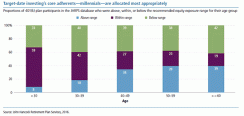
Open-architecture plan design has become the industry standard
The rise of the target-date fund as retirement’s preeminent investment option isn’t the only important advancement in the DC plan arena. At the plan design level, the shift toward open-architecture, or multimanager, investment menus has come a long way in a relatively short time.
It wasn’t that long ago that investment options in a typical plan lineup were frequently limited to those managed by one firm—usually the asset manager affiliate of the plan’s recordkeeper leaving plan participants with no choice but to devote all of their retirement assets to a single manager.
“Today, plan design best practices call for open-architecture lineups, with an unbundled mix of offerings chosen for their investment merits …”
Devoting all assets to a single manager entails risks
The same organizational efficiencies that create scale and stability across multiple DC plan service businesses can also stifle independent investment decisions. A 2010 study on management structure at investment firms suggests a strong link between hierarchy and herding, the tendency of portfolio managers to follow the trading behavior of their colleagues.4
In particular, a firm with a vertical structure, where the house view is encouraged from the top down—CEO to CIO to asset class team leaders, and so on—can impair a portfolio manager’s discretion and sense of empowerment, weakening the incentive to cultivate original insight. When all of an investment firm’s portfolio managers rely on the same central research group, it’s fair to question how they guard against groupthink.
Moreover, it’s rare to find first-rate offerings across asset classes within one firm. As portfolio management has become increasingly specialized, no one firm can be expected to excel in every investment discipline needed to build a truly diversified portfolio.
Today, manager concentration is less widespread at the plan lineup level
Recognizing the manager-concentration risks that closedarchitecture arrangements at the plan lineup level created, fiduciaries increasingly began to demand a greater range of choices for their participants. Today, plan design best practices call for open-architecture lineups, with an unbundled mix of offerings chosen for their investment merits; in fact, nonproprietary funds now represent the majority of all assets held in 401(k) plans.
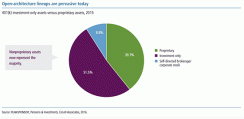
Closed architecture still dominates the target-date fund landscape
Even though best practices of DC plan design now call for open architecture at the lineup level, the most important investment option on the menu—the target-date solution itself—frequently remains closed with respect to portfolio construction.
Rather than drawing on a broad range of investment industry talent both internally and externally, closed-architecture target-date suites exclusively draw on proprietary underlying funds, all managed by the same firm.
The lasting legacy of manager concentration
Open-architecture target-date portfolio construction remains rare not only when measured by assets under management, but also in terms of the modest proportion of organizations offering them.
In a recent survey, only 31% of target-date fund providers identified their offerings as purely open architecture.5 A review of the three largest target-date fund providers reinforced this relative scarcity. Known for their closed-architecture flagship offerings, the combined 70% target-date mutual fund market share of this group totaled nearly $540 billion at the end of 2015.6
All three firms have substantial plan recordkeeping businesses, underscoring a lasting consequence linked to the days when it was common for DC plan recordkeeping services and investment options to be bundled together at the point of sale.
Elite plan advisors have made the effort to find open-architecture target-date funds
However, the retirement market is evolving, and feedback from investment consultants and elite DC plan advisors suggests a narrowing of the imbalance between closed- and open-architecture target-date funds in certain circles.
“Rather than drawing on a broad range of investment industry talent both internally and externally, closedarchitecture target-date suites exclusively draw on proprietary underlying funds, all managed by the same firm.”
A survey of the Financial Times Top 401 Plan Advisors revealed that only 43% of their clients’ target-date assets still reside in traditional, single-manager mutual funds; meanwhile 33% of the target-date assets advised by the survey’s respondents are now in multimanager mutual funds or CITs.6
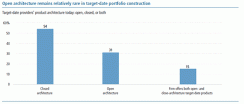
If open architecture is important, then more target-date funds should be open
Target-date fund providers have increasingly started to recognize the virtues of open-architecture portfolio construction as a concept. Some 36% of closed-architecture target-date fund providers acknowledge that integrating nonaffiliated asset managers into their offerings is either under consideration or likely.5 A strengthening undercurrent of demand is clearly prompting many proprietary players to step back and reconsider their existing target-date fund business strategies.
Serving the best interests of plan participants appears to be the ultimate driver behind these business decisions. According to 75% of the firms offering open-architecture target-date funds, “Participants benefit from asset manager diversification”; the second and third most commonly cited reasons given for outsourcing portions of investment management included limited in-house capabilities in certain asset classes (25%) and the U.S. Department of Labor’s (DOL’s) encouragement for plan sponsors to consider open-architecture target-date products (17%).5
The DOL’s nod to multimanager target-date funds strengthened their standing
The DOL has indeed suggested that plan sponsors would be wise to consider open-architecture target-date funds. In 2013, the DOL issued guidance to plan fiduciaries choosing among target-date strategies in an Employee Benefits Security Administration memorandum, which highlighted the benefits of portfolios populated with multiple managers, “thus diversifying participants’ exposure to one investment provider.”7 This explicit acknowledgment prompted the broader industry to take notice, advancing the stature of multimanager models.
If a well-built target-date fund is more than the sum of its parts, then one of the best features of an open-architecture structure is the potential to incorporate top-notch investment talent from anywhere around the globe. When carefully combined, managers from different firms who view the world differently can generate complementary patterns of return that increase a portfolio’s resilience and provide a broader range of potential sources of return.
If open architecture is important, then more target-date funds should be open, incorporating a variety of specialized teams based on their merits rather than their firm affiliations. For years, the ability to invest with multiple managers has been available to DC plan participants who do their own asset allocation by drawing on a range of individual investment options. Whether it’s by choice or by default, don’t participants delegating the asset allocation decision to professionals deserve the same?
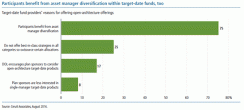
Forward-thinking fiduciaries have already taken action
Plan advisors, consultants, and sponsors at the helm of the country’s largest DC plans have responded to the shortcomings of single-manager asset allocation offerings by abandoning their recordkeepers’ proprietary target-date funds. Nearly two-thirds (64%) of sponsors overseeing plans with more than $1 billion in assets now use nonrecordkeeper target-date funds.8
Standards of care continue to advance with great speed
The recent rate of change among the largest plans is worth noting. In its survey of large and mega 401(k) plan sponsors, Callan found that those “offering their recordkeepers’ proprietary target date fund declined from 70% in 2011 to 32% in 2015.”1
Anecdotal evidence elsewhere suggests similar patterns of progression prospectively: While “85% of plan sponsors currently use only proprietary funds in their target date funds, 32% are considering a change to add non-proprietary funds."6
Moreover, 62% of plan sponsors agree that it’s “a good idea to separate asset management … from recordkeeping,” even if they have not yet implemented this idea in their target-date funds.8 However, in terms of wholesale shifts already completed, the megaplan portion of the DC market stands alone; across all smaller plan segments, recordkeepers’ target-date funds still represent the majority.
>Landmark regulations do more to guide than proscribe
While the Employee Retirement Income Security Act of 1974 (ERISA) requires plan sponsors to act solely in the best interest of the plan participants, it does not specify the types of investments a plan sponsor must offer participants; instead, fiduciaries have broad latitude in adding, removing, and replacing investment options. The main requirement is that plan sponsors select investment options through a prudent process that applies in prevailing investment industry practices—and the prevailing practices seem to be shifting. The DOL Conflict of Interest Rule, also known as the Fiduciary Rule, reinforces the notion that standards of care for retirement savers’ assets are only headed higher.
“…in terms of wholesale shifts already completed, the megaplan portion of the DC market stands alone …”
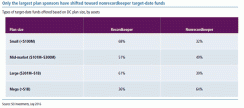
Inadequately positioned plans need to catch up soon
For plan sponsors inadequately positioned for rising fiduciary standards, the consequences can be dire. Failing to grasp the significance of their duty to participants has already cost plan sponsors at least $330 million in legal settlements, with more cases pending.9
Fiduciaries have taken notice of the rash of DC plan legal proceedings. In fact, the majority (57%) of plan sponsors report being at least somewhat concerned about potential litigation according to one study, which added that “in the current litigious climate, plan sponsors are closely evaluating all decisions from a lens of how it could expose the plan to litigation risk,” an intensified awareness prompting many to “question the appropriateness of wholly proprietary target-date products.”3
Target-date fund scrutiny in particular is rising along with fiduciary standards: 53% of plan sponsors and 76% of elite plan advisors reported an intent to “perform a comprehensive review” of their target-date fund managers in 2016.6
Operate the plan for the exclusive benefit of your employees—the fiduciary mantraWhile many legal challenges are at least nominally about fees, the plaintiffs’ attorney at the center of much of the recent ERISA litigation articulates a common thread behind the grievances that initiated his clients’ lawsuits. When asked how fiduciaries could avoid legal challenges, Jerome Schlichter, senior partner of the firm that bears his name, said, “The beacon that should guide any 401(k) plan advisor, as well as employer, is to operate the plan for the exclusive benefit of your employees and retirees … if there are any gray areas or any doubts, you come back to that beacon and let that be your standard.”10
While the requirement to act in the best interest of participants has been in place for decades, the notion of what, exactly, constitutes that best interest is far more fluid. “The standard of care for plan fiduciaries is always evolving. What may have been appropriate 10 years ago may not be sufficient today."11
When target-date funds were initially launched in the 1990s, open-architecture portfolio construction incorporating nonproprietary managers was essentially nonexistent. However, that’s not the case anymore.
Today, multiple managers can be found in select target-date fund offerings, just as multiple managers are commonly found across DC plan investment menus. If fiduciaries are still required to act solely in the best interest of the plan participants, then the time for plan sponsors to embrace open-architecture target-date funds is now.
“Target-date fund scrutiny in particular is rising along with fiduciary standards: 53% of plan sponsors and 76% of elite plan advisors reported an intent to ‘perform a comprehensive review’ of their target-date fund managers in 2016.”
Notes
1 “2016 DC Trends,” Callan Investments Institute Survey, 2016.
2 “What your older 401(k) clients can learn about asset allocation from millennials,” John Hancock Investments, July 2016.
3 “U.S. Retirement Markets 2016: Preparing for a New World Post-Conflict of Interest Rule,” Cerulli Associates, 2016.<
4 “The Role of Organizational Structure: Between Hierarchy and Specialization,” Massimo Massa and Lei Zhang, 2010.
5 The Cerulli Edge, August 2016.
6 “Opportunities in Target Date Funds,” Ignites Retirement Research, March 2016.
7 “Target Date Retirement Funds—Tips for ERISA Plan Fiduciaries,” U.S. Department of Labor, February 2013.
8 “As plan sponsors realize a redesign is needed, target date funds get a second look,” SEI, July 2016.
9 Schlichter Bogard & Denton, uselaws.com/practice-areas/erisa, 12/22/16.<
10 “How (Not) To Get Sued By 401k Tort Terror Jerry Schlichter,” John Sullivan, 401(k) Specialist, 2/19/16.
11 “Heat is rising on financial firms’ use of own strategies in their 401(k) plans,” Pensions & Investments, 6/23/14.
Learn why target-date funds from John Hancock Investments were rated #1 for open architecture.
This material is not intended to be, nor shall it be interpreted or construed as, a recommendation or providing advice, impartial or otherwise. John Hancock Investments and its representatives and affiliates may receive compensation derived from the sale of and/or from any investment made in its products and services.
This commentary is provided for informational purposes only and is not an endorsement of any security, mutual fund, sector, or index. The information contained herein is based on sources believed to be reliable, but it is neither all inclusive nor guaranteed by John Hancock Investments.
This material does not constitute tax, legal, or accounting advice, and neither John Hancock nor any of its agents, employees, or registered representatives are in the business of offering such advice. It was not intended or written for use, and cannot be used, by any taxpayer for the purpose of avoiding any IRS penalty. It was written to support the marketing of the transactions or topics it addresses. Anyone interested in these transactions or topics should seek advice from independent professional advisors based on his or her particular circumstances.
Diversification does not guarantee a profit or eliminate the risk of a loss.
A note on target-date funds: The portfolio’s performance depends on the advisor’s skill in determining asset class allocations, the mix of underlying funds, and the performance of those underlying funds. The portfolio is subject to the same risks as the underlying funds and exchange-traded funds in which it invests: Stocks and bonds can decline due to adverse issuer, market, regulatory, or economic developments; foreign investing, especially in emerging markets, has additional risks, such as currency and market volatility and political and social instability; the securities of small companies are subject to higher volatility than those of larger, more established companies; and high-yield bonds are subject to additional risks, such as increased risk of default. Each portfolio’s name refers to the approximate retirement year of the investors for whom the portfolio’s asset allocation strategy is designed. The portfolios with dates further off initially allocate more aggressively to stock funds. As a portfolio approaches and passes its target date, the allocation will gradually migrate to more conservative, fixed-income funds. The principal value of each portfolio is not guaranteed, and you could lose money at any time, including at, or after, the target date. Liquidity—the extent to which a security may be sold or a derivative position closed without negatively affecting its market value, if at all—may be impaired by reduced trading volume, heightened volatility, rising interest rates, and other market conditions. Hedging and other strategic transactions may increase volatility and result in losses if not successful. Please see the portfolio’s prospectus for additional risks.
A fund’s investment objectives, risks, charges, and expenses should be considered carefully before investing. The prospectus contains this and other important information about the fund. To obtain a prospectus, contact your financial professional, call John Hancock Investments at 800-225-5291, or visit our website at jhinvestments.com. Please read the prospectus carefully before investing or sending money.






